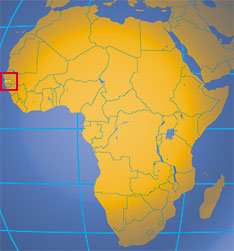Gambia
 Ministry
of Petroleum
Ministry
of Petroleum
BertilHarding High Way,Kotu,Greater Banjul
The Gambia
Tel no:+220 880 6317
+220 8806315
Fax: +220 820 0896
http://www.gambia.gm/index.htmlThe Gambia
Tel no:+220 880 6317
+220 8806315
Fax: +220 820 0896
CIA Factbook
Political rights and civil liberties (Freedom House)
Travel and accommodation
The contribution of mining to total exports in 2010 amounted to 15.6%
Gambia Mining News
Source: CIA Factbook
Legend
Legend
Geology
A trans-Senegal-Gambian border titanium–zirconium heavy mineral sands operation, which was commissioned in 2006, was shut down in The Gambia in early 2008. Production figures for 2007 were unavailable. Total resource was estimated at 18.8 Mt containing 1 Mt of heavy minerals (71% ilmenite, 15% zircon and 3% rutile). The country did not produce any hydrocarbons and is dependent on imports of petroleum for its domestic energy requirements.
Maps and images
- Gambia Cities,Towns, Airports, Maps, Images
- Gambia Geology
- Gambia Image-1
- Gambia Image-2
- Gambia Minerals
- Available Geological Maps (2)
Natural
Resources Including Petroleum Prospects
(Source: Gambian Government )
The
following minerals have been identified in The Gambia following some
mineral exploration programmes conducted with the lead participation
of the Geological Department. The Government continues to monitor
research findings on the possibility for more mineral deposits,
especially those with higher marketing value whilst staying mindful
of conservation and environmental preservation issues. There are
known deposits of:
a) Quartz
Sand
Large
reserves of quartz (silica) sand, suitable for glass manufacture,
have been identified in the Greater Banjul Area, notably in Abuko,
Brufut, Darsilami (Western Division); Mbankam and Bakendik (North
Bank Division); and Kaiaf, (Lower River Division). The Government
continues to seek interested investors to exploit these deposits
b) Heavy
Mineral Beach Sand Deposits
The
raised beach sand, which is characteristic of The Gambia's coastal
beaches, contain ilmenite, rutile, and zircon. The deposits were
briefly mined in the past and recently the Government is keen in
attracting interested investors in exploiting the deposits.
The
estimated reserves of recoverable minerals yield a conservative total
of about 995,000 tonnes at a 1% cut-off grade. Further investigations
will be conducted to update the reserve base of these minerals.
c) Hydro
Carbon Potential
The
Gambia depends on imported petroleum products. The government
recognises the critical need for secure and stable supply of
petroleum products and the need to stabilise prices to avoid induced
inflation. The government therefore welcomes potential investors and
collaborators in improving storage. In regards to petroleum prospects
(hydro carbon potential), The Gambia has promising prospects and the
government is relentlessly collecting, updating and storing the
relevant seismic data and marketing the prospects to interested oil
companies and businesses.
d) Liquefied
Petroleum Gas (LPG)
All
liquefied petroleum gas in The Gambia is imported overland from
Senegal. LPG is mostly used for domestic purposes and on a limited
scale for industrial purposes. Transaction costs in importing and
bottling gas have resulted in large price differentials between
Senegal and The Gambia. This makes gas unaffordable to most Gambians,
and hence constituting a severe limitation on the promotion of the
use of LPG.
- Amerada Hess (80 percent interest) and Sterling Energy plc (20 percent) hold the rights to The Gambia's Deepwater PPL Block. The license has been issued for six years and the companies are currently finalizing interpretation studies and evaluating options for a 3D seismic data acquisition.
- In July 2005, The Gambia awarded Philippine National Oil Company (PNOC) one of The Gambia’s six oil exploration blocks. The Gambia gave the award to PNOC without tender, or a technical review of the company’s capabilities.
- Buried Hill Energy, a Canadian company, has two licenses for the exploration and production of oil and gas in the offshore area. Buried Hill has identified five distrinct areas with 26 targets and wants to start drilling in early 2009.
References
Economic geology of energy sources
- Petroleum Developments in Central and Southern Africa in 1972
- Petroleum Developments in Central and Southern Africa in 1972
Economic geology of ore deposits
Economic geology, general
- The Gambia
- The mineral industry of other African areas
- The Mineral Industry of Other African Areas
- The mineral industry of other areas of Africa
Economic geology, general, economics
- Financing African mining developments; Mining activity survey
- Les mines de fer mondiales et la préparation des minerais - Afrique


